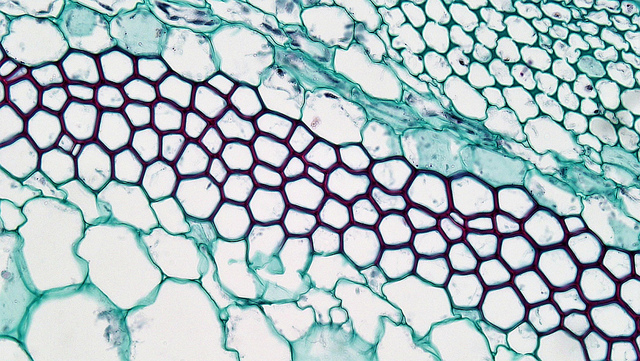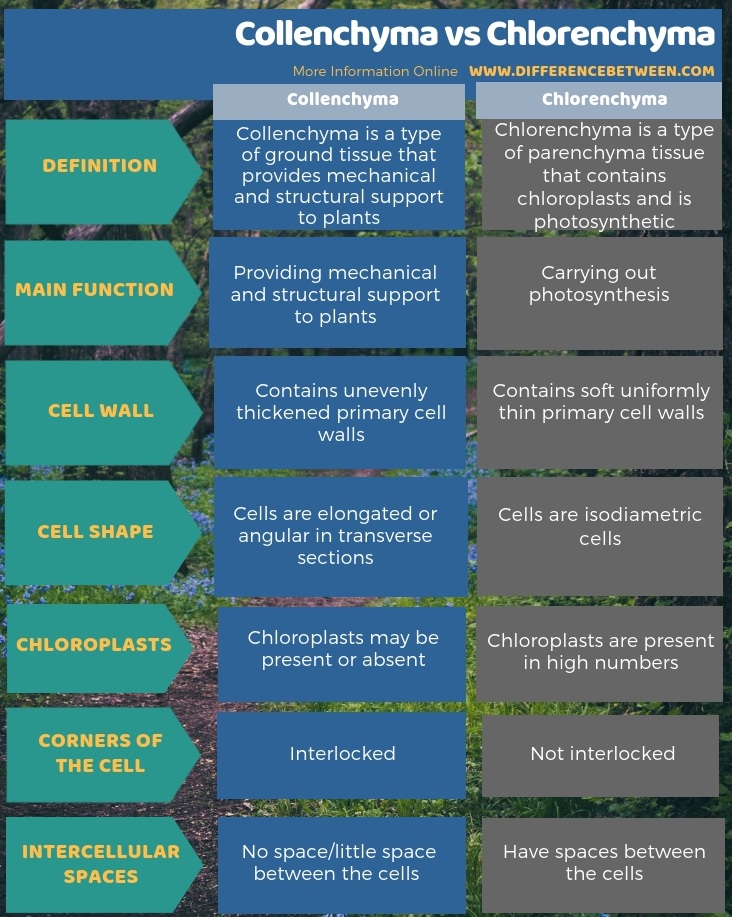Difference Between Collenchyma and Chlorenchyma
The key difference between collenchyma and chlorenchyma is that collenchyma is a type of ground tissue that provides mechanical and structural support to a plant while chlorenchyma is a modified parenchyma tissue that contains chloroplasts and is photosynthetic.
There are three types of ground tissue as parenchyma, collenchyma, and sclerenchyma. They are neither dermal nor vascular. Parenchyma cells are typical plant cells with thin primary cell walls. They remain alive even at maturity. Parenchyma cells act as the filler tissue in the soft parts of the plants. Whereas, collenchyma cells also have primary cell walls, but they possess secondary thickenings in some areas of the cell wall. Hence, they provide mechanical support as well as structural support to the plant. Moreover, sclerenchyma cells have heavily thickened secondary cell walls, but these cells die at maturity. They don’t contain nucleus and cytoplasm at this stage. Also, they are the prime cells that provide structural support to the plant. Thus, chlorenchyma is a special type of parenchyma tissue which is photosynthetic.
CONTENTS
1. Overview and Key Difference
2. What is Collenchyma
3. What is Chlorenchyma
4. Similarities Between Collenchyma and Chlorenchyma
5. Side by Side Comparison – Collenchyma vs Chlorenchyma in Tabular Form
6. Summary
What is Collenchyma?
Collenchyma is one of the three types of ground tissues present in plants. Collenchyma cells have unevenly thickened primary cell walls. The cell wall is made up of pectin and hemicellulose. These cells are elongated or angular in shape in transverse sections. These cells are living cells even at maturity though they have cell wall thickenings. There is only a small space/no space between collenchyma cells.

Figure 01: Collenchyma
Generally, collenchyma tissue provides mechanical and structural support to plants. Epidermal layer of plants mainly constitutes of collenchymas cells. Furthermore, collenchyma cells are present in leaves, stems, and petioles.
What is Chlorenchyma?
Chlorenchyma is a modified parenchyma tissue present in the mesophyll tissue layer of leaves and stems of plants. The tissue contains chloroplasts; hence, it is photosynthetic. It also performs the storage function in plants. Cells of the chlorenchyma tissue are isodiametric in shape.

Figure 02: Chlorenchyma in Plant Leaves
Cells have uniform thin cell walls. They do not undergo secondary thickenings, unlike collenchyma cells. Furthermore, they have spaces between the cells, unlike collenchyma cells.
What are the Similarities Between Collenchyma and Chlorenchyma?
- Both collenchyma and chlorenchyma cells are living cells.
- Also, both are plant cells.
- Furthermore, both have a nucleus and a cytoplasm.
- And, they are simple permanent tissues.
What is the Difference Between Collenchyma and Chlorenchyma?
Collenchyma tissue is a type of ground tissue that contains unevenly thickened cells while chlorenchyma is a modified parenchyma tissue that contains chloroplasts and is photosynthetic. Thus, we can consider this as the key difference between collenchyma and chlorenchyma. Besides, collenchyma tissue provides mechanical and structural support to plants while chlorenchyma tissue helps in photosynthesis and storage. Hence, this is the functional difference between collenchyma and chlorenchyma.
Furthermore, collenchyma cells have unevenly thickened cell walls while cell walls of chlorenchyma cells are uniform. In addition, corners of the collenchyma cells are interlocked while this interlocking is not seen in chlorenchyma cells. Therefore, this is the structural difference between collenchyma and chlorenchyma cells.
The below infographic tabulates more information on the difference between collenchyma and chlorenchyma.

Summary – Collenchyma vs Chlorenchyma
In summarizing the difference between collenchyma and chlorenchyma, the collenchyma is a ground tissue composed of unevenly thickened cells. In contrast, chlorenchyma is a specialized parenchyma tissue for photosynthesis. Thus, this is the key difference between collenchyma and chlorenchyma. Furthermore, collenchyma cells provide mechanical and structural support to plants while chlorenchyma cells carry out photosynthesis and storage functions. Moreover, collenchyma cells are elongated or angular cells while chlorenchyma cells are isodiametric in shape. Collenchyma cells may or may not contain chloroplasts while chlorenchyma cells have a higher number of chloroplasts.
Reference:
1. “Ground Tissue.” Wikipedia, Wikimedia Foundation, 24 Feb. 2019, Available here.
Image Courtesy:
1.”Anatomia foglia g1″ By Giancarlodessi assumed- Own work assumed (based on copyright claims) (CC BY-SA 3.0) via Commons Wikimedia
2. “Herbaceous Dicot Stem: Collenchyma, Sclerenchyma and Parenchyma in Cucurbita” By Berkshire Community College Bioscience Image Library (Public Domain) via Flickr
ncG1vNJzZmivp6x7pbXFn5yrnZ6YsqOx07CcnqZemLyue8OinZ%2Bdopq7pLGMm5ytr5Wau26vzqWjnqaTncaurYyapZ1lk525sL7Ep5qhsZ2WfA%3D%3D